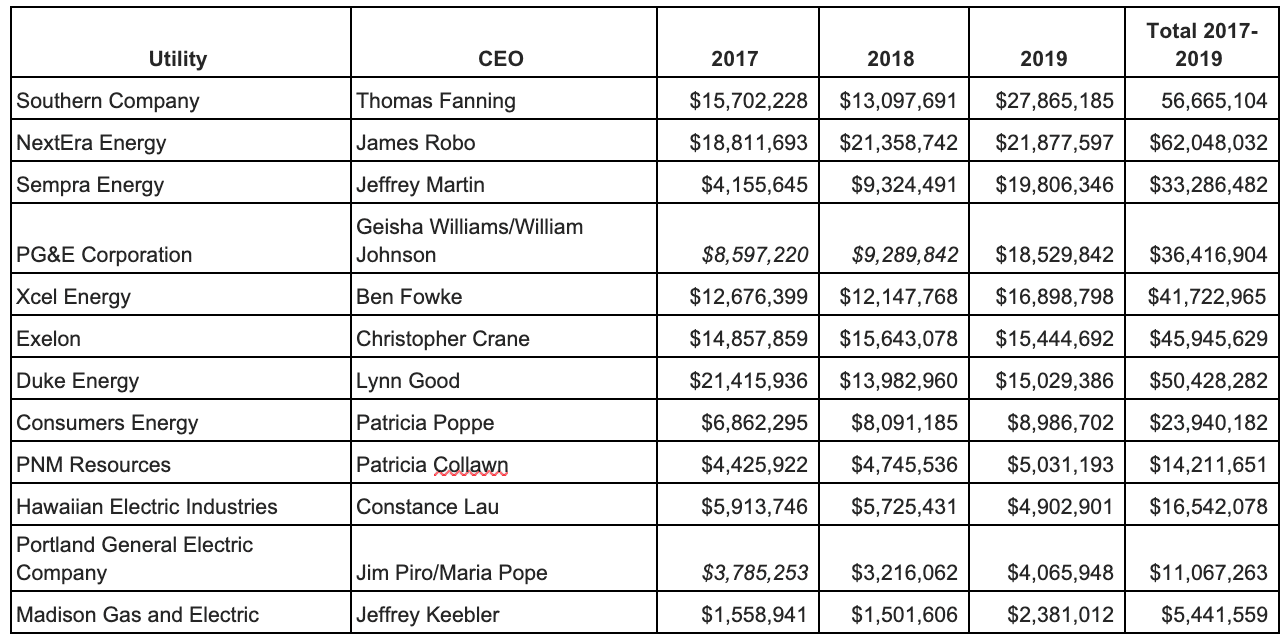Corporate America pays its CEOs well — especially those making money for shareholders — and the country’s investor-owned utilities (IOUs) are no exception.
So, as Southern Company’s stock soared in 2019, the compensation of CEO Thomas Fanning more than doubled, from $13.1 million in 2018 to $27.8 million last year.
That eye-popping raise topped a new list from the watchdog group Energy and Policy Institute, tracking the past three years of CEO compensation at 41 IOUs across the country. (The table below is an abbreviated version; the full list is available here.)

Culled from company filings with the Securities and Exchange Commission (SEC), the figures in most cases reflect total compensation, in which base pay is often dwarfed by bonuses, incentives and stock options. For example, Pacific Gas and Electric’s now-departing CEO William Johnson started with a base pay of $2.5 million a year, but according to EPI’s figures, had a total compensation package of $18.5 million.
Johnson’s predecessor, Geisha Williams, earned only about half that amount, $8.6 million in 2017 and $9.3 million in 2018, reflecting the generally lower pay for female CEOs on the list. Lynn Good at Duke Energy is the outlier here at $15 million, which still puts her on the lower end of 2019’s highest-paid CEOs.
Clearly, these CEOs are overpaid, but it’s harder to gauge the true value they provide as leaders of the utilities that generate and deliver the electricity that makes modern life possible — a fact thrown into sharp relief by the Covid-19 pandemic.
Pay disparities between IOU executives and essential positions, such as linemen, are one measure. According to the U.S. Bureau of Labor Statistics, the national average salary for linemen is $70,240, a sliver of the compensation for top CEOs such as Fanning, NextEra’s James Robo and Sempra’s Jeffrey Martin.
Looking at CEO compensation for some of the nation’s larger municipal utilities and electric cooperatives provides another point of comparison — between for-profit IOUs and community-based, nonprofit munis and co-ops. At CPS Energy in San Antonio, the nation’s largest municipal utility, CEO Paula Gold-Williams has a total compensation of $930,669, split about evenly between base and bonus pay.
Another Texas utility, the Pedernales Electric Cooperative, covers a service area almost the size of New Jersey. CEO Julie Caruthers Parsley earns $437,450 — a figure drawn from the co-op’s tax forms, available on its website.
Which brings us back to the central question of how to value the performance of utility CEOs, and whether supporting deep grid decarbonization, broad customer choice and truly competitive solar markets are in the mix. Some of the highest-paid CEOs on the EPI list head utilities — such as Southern Company and NextEra — that have slowed the growth of residential solar in their regions.
According to its 2018 Sustainability Report, Sempra Energy sold all its renewables and intensified its focus on developing natural gas infrastructure; it also doubled CEO Jeffrey Martin’s pay twice — from $4.2 million in 2017, to $9.3 million in 2018 to $19.8 million last year.
This content is protected by copyright and may not be reused. If you want to cooperate with us and would like to reuse some of our content, please contact: editors@pv-magazine.com.








“Pay disparities between IOU executives and essential positions, such as linemen, are one measure. According to the U.S. Bureau of Labor Statistics, the national average salary for linemen is $70,240, a sliver of the compensation for top CEOs such as Fanning, NextEra’s James Robo and Sempra’s Jeffrey Martin. ”
Several years back, I want to say it was utility dive that published an article about electric utilities and overall costs and overhead. The top 24 executives of the large utilities are making right around 5% of the wages and benefits paid to company employees. Some utilities offer stock options and performance options in the MOU with this (elite) top 24, it may be 10% of wages and benefits on some years. Imagine 20,000 employees and the top 24 of the company are bringing in 5% to 10% of wages and benefits. You could sure buy some equipment and put another 50 to 100 linemen in service instead of 24 individuals that are there to basically (hide behind). The board of directors hires a CEO and hides behind (him/her). The CEO hires all of these “other” executives supposedly to help steer the company into profitability. In reality the Board of directors hide behind their CEO and he hides behind the top 24, nobody is held accountable unless there are pictures of an executive with a goat in bed, then, there will be a scathingly harsh “review” of policy.
Personally, I believe since these well compensated top 24 are “supposed” to be the movers and shakers of the utility, when they screw up or one of their “hired” consultants screws up, one might have “stranded assets” because of such decisions. Things like retrofitting an old coal fired plant to natural gas fired boilers, then finding out another project has rendered it as a “stranded asset”. At that time it is NOT appropriate to saddle the ratepayers with executive incompetence by raising their electric rates for this “stranded asset”. Take the top 24 or even the top 50 involved with this idiocy and decrease their pay 30% until the stranded asset “they” created is paid off.
That guy at PG&E mentioned William Johnson, was the CEO of TVA in charge when the Kingston coal fired plant, fly ash pond breached and flowed into the Clinch river, spoiling the eco system for years to come. I understand he is out in a couple of months and the “interim” CEO will be one of the “board of directors” until a “new” CEO is hired. Apparently he was paid $18 million so the board could hide behind their louse O&M record, sorry excuse for a wildfire remediation program, the PSPS and ongoing excuses used to deflect decades of maintenance mismanagement and dilatory infrastructure hardening.
“Some of the highest-paid CEOs on the EPI list head utilities — such as Southern Company and NextEra — that have slowed the growth of residential solar in their regions. ”
Same tired utility practice, “we” own the asset, so, “we” control the grid and the costs per kWh of electricity sold. All of these utilities are the same. “Curtail” solar PV and or wind generation during the “duck curve” and use more expensive fueled generation to ramp around grid demands. Then invoke a TOU rate spiking program to increase fueled generation rates above regular retail rates during the (TOU) time of day, usually from 4 PM to 9 PM each day.
Curious as to which of these companies paid more to their CEO’s in comp. than they did to Uncle Sam in federal taxes. I am guessing there is a strong positive correlation.
Literally a research question. I’ll add it to my list of justifications for municipalizing and expanding co-operative and other public ownership models.
I’m hoping that more institutional investors put more pressure on IOUs to get on with the renewables. California where I’m at is already there. But there are a bunch of states that are lagging, especially Florida. Hopefully a regime change next year will “drain the swamp.”